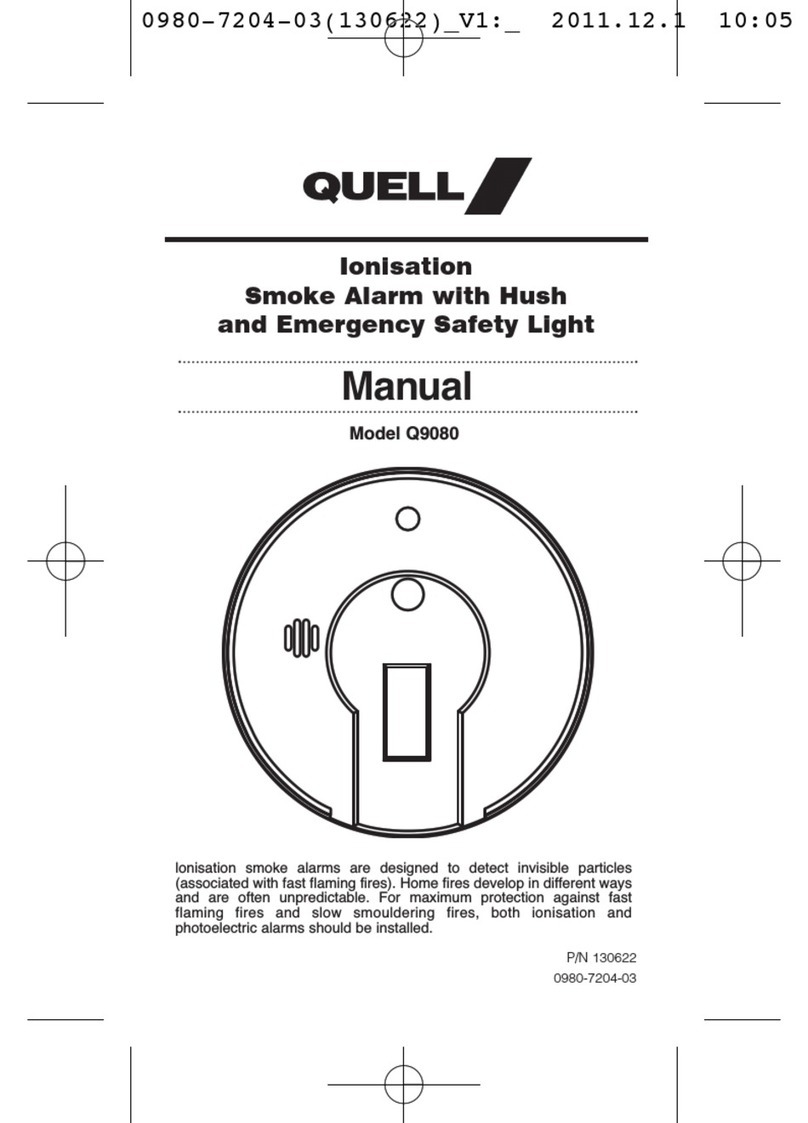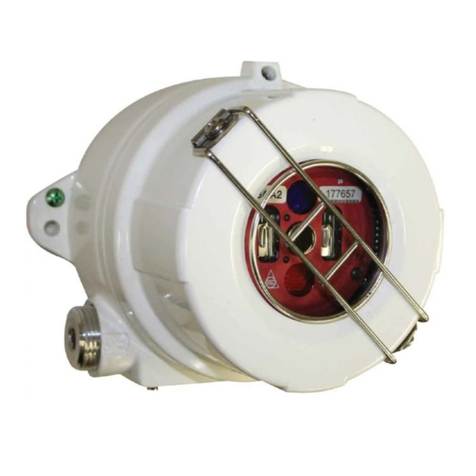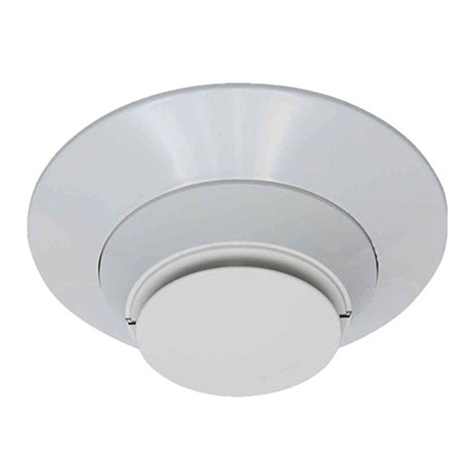STRATOS HSSD User manual

Technical Manual
Issue 2.4
Quality system cert. no. 404
Assessed to ISO 9001
afp-813

World Patents Pending ©AirSense Technology Ltd. 1999
ISSUE 2.4
Page 2
TECHNICAL.MANUAL
Introduction 3
Background 4
Heat Detectors 4
Ionisation Detectors 4
General Optical Detectors 5
Beam Detectors 5
Light Scattering Detectors 6
Light Sensing Detectors 6
Point Detectors 7
High Sensitivity Aspirating Systems (a.k.a. Air Sampling Systems) 9
Specific types of Aspirating Systems. 11
Particle counters 12
Light scatter (mass detection) systems 12
Light sources 13
Absolute v. relative scaling 15
Absolute Scaling 15
Relative Scaling 16
Stratos-HSSD®17
Description 17
Histograms and Learning 17
Dust 19
Bargraph Scale 20
Power Supplies 21
Using an external power supply 21
Chart recorder analogue output 22
Examination of referencing systems 22
Stratos detector referencing 32
Local and remote referencing 34
Terminal board jumper link connections 35
Apollo Series 90 Interface 35
Autronica BNX-3 36
Thorn AM521 37
Remote control software 38
Using the remote control software 38
Setup menu 38
Demonstration and log menu 40
Diagnostic menu 41
Chart recorder format 42
Histogram format 43
Product id numbers 43
Remote monitor format 44
Remote monitor programming API 45
Chart recorder sample rates 46
PipeCAD™ for Windows 47
Sampling Pipe Modelling Program 47
System requirements 47
Installation 47
World Patents Pending ©AirSense Technology Ltd. 1995
Contents
Produced by AirSense Technology Publications.
Written by Mark Symonds - Technical Manager, Kit Girling, Technical Director
© AirSense Technology Ltd. 1999
No part of this Technical Manual may be reproduced, copied or transmitted by any
means without the express written permission of AirSense Technology Ltd.
TECHNICAL.MANUAL

World Patents Pending ©AirSense Technology Ltd. 1999
ISSUE 2.4 Page 3
TECHNICAL.MANUAL
Introduction There are now several air sampling smoke detection systems on the world Fire
Protection market that operate at ‘High Sensitivity’ levels as defined by the tests
described in BS6266 1992. The AirSense Technology Ltd Stratos-HSSD® detector is
at time of writing, the latest entry in this field, and is designed to overcome many of
the shortcomings found in other systems. In order to understand Stratos it is useful to
haveacursoryknowledgeofthefiredetectionsystemsthatprecededit,whetherpoint
detectors, large area detectors or other aspirating smoke detection systems.
It is a truism that early detection of fires is the key factor in preventing them from
developing. The earlier they are detected and extinguished, the less damage will be
caused. It is not until one looks at the evolution of detection systems that one can see
where such a simple truism can lead. The major requirement of any system is,
obviously, to detect fire, but, not quite so obviously, to not give a warning when no
fire occurs! The problem of unwanted alarms is a major one; for instance frequent call
outs to deal with non-existent fires can lead to a tendency for alarms to be ignored.
Unwanted alarms, from whatever cause, can largely negate the usefulness of any
alarm system and for this reason the ability to not give unwanted alarms must be rated
as high in importance as the ability to signal a true alarm.
United Kingdom
01462 440666
Netherlands
+31 1825 635696
Finland
400 652131
Australia
(08) 618 8443 9625
Help Lines &AirSense Technology has taken every care to ensure that Stratos is as simple to install as
possible, but in case of difficulty please contact our Help Line to ensure trouble free
installation.
About the author
The author has been involved for many years with the design of various successful fire
detectionproducts.Formanyyearshewasalso Electronic Engineering Manager ofthe
Company that first imported High Sensitivity aspirating Smoke Detection products to
Europe from Australia. He was subsequently involved in making this earlier generation
system suitable for application in the European fire market and developing differing
variants of this system. Since February ’93, Kit Girling has been responsible for leading
the design team that has developed the Stratos-HSSD®system.

World Patents Pending ©AirSense Technology Ltd. 1999
ISSUE 2.4
Page 4
TECHNICAL.MANUAL
Many principles have been used to detect fire and are still in use, although some are
only used in special applications. The following comments describe some of the more
commonly used principles:
All fires give off heat, and sensing the temperature of the air at a given point in a given
zone can indicate the presence of a fire occurring in it. The method is simply to sense
if the temperature rises above a pre-determined trigger level and give a warning. If the
trigger temperature is low, relatively early warning can be given. Unfortunately an
unwanted alarm could be generated by heating systems being switched on or a heat
wave occurring, taking it above the trigger temperature. If the trigger temperature is
high, the fire may be well alight before warning is given. Such a system is unlikely to
be ideal in many applications.
In order to improve on this situation, the ‘Rate of Rise’ temperature detector is more
often used. These sensors do not measure the actual temperature, but the rate at
whichit increases. In this detector, the background temperature islargelyignored, but
if the rate at which the temperature rises is greater than a given amount, it is assumed
that this is due to a fire. Unfortunately, for general use, the unwanted alarm conditions
still occur even if not so readily as with the simple heat detector; also the fire must be
well alight to generate the rates of rise of temperature required to trigger them.
Heat detectors must either be strategically placed with respect to potential fire sources
or have a very high placement density in order to be effective. The heat of the fire must
also be transmitted to them rapidly.
Carbon products are given off in the form of smoke and gasses when a fire occurs. If
a small sample of air is ionised by means of a radioactive substance, then the ions will
allow a small electrical current to flow between two electrodes placed in the sample.
If the combustion products mix with the air in the sample then they will inhibit the
movement of the ions that then as a result de-ionises, and the electrical current will
decrease. This is the operating principle of the Ionisation detector. A low concentra-
tion in the air of the products of combustion is required to effect a detectable change
in the current, and this can make the detector quite sensitive. Unfortunately the
current is also effected by draughts in the air and to a lesser degree by humidity,
atmospheric pressure and temperature. Although these unwanted effects can be
Background
Ionisation Detectors
Heat Detectors

World Patents Pending ©AirSense Technology Ltd. 1999
ISSUE 2.4 Page 5
TECHNICAL.MANUAL
minimised, the combination of them, and the very small nature of the ionisation
current (10 - 50 picoamps), limit the sensitivity and usefulness of ionisation detectors.
It should also be noted that the use of radioactive elements is generally frowned upon
by today’s society because of the difficulty in safely disposing of them. The main
advantage of this type of detector is its simplicity of manufacture and low cost.
General Optical Detectors
The standard used for measuring the concentration of smoke in air is the amount of
attenuation it will cause in the intensity of a light beam shining through it, usually
expressed as ‘percent obscuration per metre’. When the smoke is invisible, such as that
which can effect an ionisation detector, then a correlation is derived between the
different types of smoke, visible and invisible. The measurement units for optical
detection systems always end up as ‘percent attenuation per unit length’ because they
can be translated into an accurate laboratory measurements.
The different principles of Optical detection are described below.
Asimplified adaptation of thelaboratorymeter described above immediatelybecomes
interesting as a smoke detector. The laboratory instrument itself is costly to manufac-
ture, and is impractical as a commercial smoke detector due to calibration problems
in an industrial situation. In order to make it commercially viable, the specification
must be changed so that dust build-up etc. does not cause unwanted alarms. A large
attenuation of the beam is required (typically 30 - 50%) and consequently it needs to
cover large areas. The attenuation in light is achieved by several means, but a
commonly used method is to shine a collimated light beam through many metres to
a reflector from which the light is reflected toward a light sensor near the beam source.
Smoke occurring in the beam will attenuate its intensity, and this reduction in intensity
will be used to trigger an alarm. Such a system is also good at detecting mist, steam
or dust, also anything that may physically interrupt or reduce the beam intensity. Dirt
build-up on lenses and reflectors have been known to cause serious problems, as have
normal movement in buildings caused by temperature changes and wind.
Beam Detectors

World Patents Pending ©AirSense Technology Ltd. 1999
ISSUE 2.4
Page 6
TECHNICAL.MANUAL
Another type of optical detector is immediately suggested by the beam detector, when
one considers what happens to the light in the beam that is not returned to the sensor.
Very little of this light will be ‘absorbed’ (e.g. translated to another energy form). Most
of it will be scattered out of the light beam, and hence not returned to the sensor. The
suggestion is, that if the scattered light itself is sensed, its intensity would be a direct
measure of the scattering medium or smoke. This principle is used very successfully in
many detectors although it is more expensive to realise than an ionisation type detector,
but gives a more reliable and potentially more sensitive detector.
A second type of optical light scattering detector uses a tightly focused laser beam to
produce pulses of light which are scattered from individual particles in an air stream
passing through the point of focus of the laser. This is the ‘particle counter’ detector,
which was originally designed for monitoring the quality of Clean Rooms (microelec-
tronics and pharmaceutical manufacture and research). For smoke detection it is only
viable when used in an aspirating system.
Light Scattering
Detectors
Most fires will generate light of one sort or another, infrared light being the most
prominent. Extremely sensitive infrared cameras are available, which could be used in
an alarm system. Such cameras are not used due to their high cost and the problem of
identifying the position of a fire but they could provide a means of identifying very small
temperature rises. The source of heat must be visible to the detector, either directly or
by reflection. This is not the case though with most other types of detector. A simplified
version that did not produce an image could be acceptable for fire detection although
it would not pinpoint the source of the heat in the same way that a camera would.
A flaming fire will produce a flickering ultraviolet light, and an ultraviolet sensor can be
used to detect it while also discriminating against other sources of ultraviolet, arc
welding for example, by means of the flicker rate. When materials burn they produce
light of different colours depending upon the elements that constitute the material.
These colours are produced in certain proportions and sensors can be made selectively
responsive to these colours by means of colour filters. By sensing the colours of light in
the required proportions an alarm can be triggered. The response time of such a
detector can be extremely rapid.
Light sensing fire detectors tend to have specialised uses, furthermore, although the
Light Sensing
Detectors

World Patents Pending ©AirSense Technology Ltd. 1999
ISSUE 2.4 Page 7
TECHNICAL.MANUAL
response time to fire may be rapid enough to detect flame within a few milliseconds,
most fire situations will progress through a relatively long smouldering period, and
generally light sensing detectors are either not sensitive to this stage or are inefficient
at detecting it.
There are many variations on these principles, they are also used with varying degrees
of technical expertise in order to suit different markets and applications. In general the
sensitivity and reliability of a detector, of whatever principle, can be improved with an
increase in cost. The large majority of detector designs are ‘point’ type, for either
consumer or commercial use, where, due to the highly competitive nature of the
market, costs have to be kept to the minimum. In the great majority of cases, detectors
are operated from a remote control unit, and one control unit will usually have many
detectors connected to it. The control unit provides the power necessary for them to
operate and itself operates fire sounders, automatic signalling to a remote centre (e.g.,
the Fire Brigade), fire extinguishing systems, etc. It normally indicates the signals it is
receiving from the detectors by means of lamps but the use of special PC programmes
to display more comprehensive information, is becoming more common.
This is the name given to the type of detector normally found in most buildings
distributed on the ceilings. A point detector depends upon normal air currents and
convection to carry the smoke, products of combustion or heat to it. For this reason,
the volume covered by the detector is limited. Where large volumes need to be covered,
more detectors are used and in very large volumes a great many detectors may be
required to provide complete coverage. There needs to be more than one tier of
detectors for very high volumes.
In the earlier days of such detection, all these detectors were wired in parallel on a single
pair of wires from a control panel. The wires provided electrical power to the detector
and also carried the alarm signal. The cost of the wires makes a significant contribution
to the total cost of the installation. Since the system must continue running during a
mains power failure, back-up batteries are required to take over at such times. The
capacity of the batteries will depend upon how much power each detector needs to run
it. In order to keep the size and cost of batteries low, point detectors are designed to
draw very low currents.
Point Detectors

World Patents Pending ©AirSense Technology Ltd. 1999
ISSUE 2.4
Page 8
TECHNICAL.MANUAL
Any detector on the pair of wires which signals an alarm is signalled back to the control
panel. This type of control panel is unable to say which of the many detectors had
operated, so the signalling is only ‘zonal’. Later developments use an addressable system
whereby the detector is given an coded unique identification which forms part of the
signal back to the control panel. The control panel can identify which of the detectors
(or other alarm device) on a given pair of wires is signalling. The detector can also signal
back more information than a simple alarm state, for instance; it can signal back that it
has a fault or pre-alarm condition. This has the effect of allowing the ‘pinpointing’ of
which detector has given the alarm and it also allows rapid identification of certain faults
in a detector.
Since a large number of detectors is often needed in a point detection system, the cost
of each unit must be kept within tolerable limits. In order to do this the design is kept
reasonably simple and the performance is consequently comparatively modest com-
pared to that possible with modern technology. In addition to this, National Standards
always demand a limit to maximum sensitivity of these devices in an effort to reduce
unwanted alarms. Point detectors are usually set to give an alarm at a smoke density
corresponding to between 2% and 4% obscuration per metre. Although they are
capable of signalling a fault condition, they will not signal the occurrence of every
possible type of fault.
Although these detectors often provide quite adequate protection, the probability of
them giving an unwanted alarm could, in some cases, be lessened by a more costly
design, and the sensitivity could be increased if cost were no object. Their general
performance reliability, although good, may not be as high as that required by a person
wishing to protect a very valuable property, and a higher sensitivity would certainly give
an earlier warning. Where very valuable property is to be protected by point detectors,
or where certain fire extinguishing systems are to be automatically released, two
different types of point detector are commonly used in a ‘coincidence’ (or ‘double
knock’) configuration. This configuration requires an alarm to be indicated by both of
the detectors before it is accepted. Since two detectors of the same principle would be
equally susceptible to the same source of unwanted alarm, usually they are of different
operating principles, e.g. a heat detector and an ionisation detector. The probability
that such a configuration will give an unwanted alarm is very much less than with a single
detector. Normallydetectorsare specially selected to suit the hazards in the volume they

World Patents Pending ©AirSense Technology Ltd. 1999
ISSUE 2.4 Page 9
TECHNICAL.MANUAL
are protecting; to give a rapid and sensitive alarm. The price paid for this degree of
certainty is the time delay required for both detectors to trigger an alarm and the
effective sensitivity are reduced to that of the least suitable detector of the pair.
Where a large volume is to be covered or an area is to be covered at a high sensitivity;
instead of using many low cost, inherently low sensitivity point detectors, an Aspirating
system may be used. Such a system consists of a single, more sensitive and highly
developed detector and an air sampling system to cover the required volume. The air
sampling system consists of a length or lengths of pipe with strategically placed
sampling holes along its length. An air impeller is used to draw air along the pipe from
the sampling holes and through the detector measuring chamber. The transit time for
air to travel from the sampling holes to the detector head can be significant, so there
must be significant advantages to this system to offset this delay. The detector is
designed to be stable, reliable and highly sensitive (approximately 10 to 200 times the
sensitivity of a point detector). Such additional sensitivity allows the detection of smoke
at a very much earlier stage in the development of a fire, and as a consequence, this may
reduce damage levels considerably. This saving of time more than offsets the delay due
to the transit time.
Aspirating smoke detectors are susceptible to considerable dilution of smoke in the air
sample, and it is important that this effect is understood. For example, if it is assumed
that a detector chamber has a typical sensitivity of 0.1%/metre obscuration, and it is
drawing its sample through ten holes in the length of pipe, and that each sampling hole
contributes equally to the volume through the detector measuring chamber, then if
smoke only effects one of the sampling holes, then, due to dilution from the other 9
holes, the actual detector responsiveness will only be equivalent to a 1% detector. If
however, say 5 of the 10 holes are effected by smoke, the apparent sensitivity will be
0.5%/metre. The more widespread the distribution of smoke among the sampling
holes, then the higher will be the density of smoke appearing in the chamber, and the
apparent sensitivity will be greater. Sampling pipe design should take this effect into
consideration.
The action of pulling air into the air sampling system gives a better smoke collection
method than the naturally occurring air convection relied upon by point detectors, and
the sampling pipe systems frequently allow the sampling holes to be strategically better
High Sensititivity
Aspirating Systems
(a.k.a. Air Sampling
Systems)

World Patents Pending ©AirSense Technology Ltd. 1999
ISSUE 2.4
Page 10
TECHNICAL.MANUAL
placed, for example in an air extraction system or within smoke strata which may be
anticipated.
.
A high sensitivity aspirating detector can cover the same volume as many point
detectors, but with added advantages. Economically speaking this allows more money
for the cost of the detector, which, in turn allows it to be designed to be considerably
more sensitive, but with the added advantages of being considerably more stable. The
removal of stringent economic factors also allow a higher degree of repeatability in
performance with a similar reliability to a great quantity of point detectors.
The added advantages of an aspirating system make it the natural choice where very
reliable performance is required. The ability to use a very sensitive system is an
advantage for protecting very clean environments such as computer rooms or micro-
electronics or pharmaceutical manufacturing clean rooms. The air sampling inlets can
be very nearly invisible which makes them ideal for use in historic buildings, where point
smoke detectors would detract from the appeal of the building. Other important
applications are found where their specific properties include; museums, art galleries,
warehouses,telephoneexchanges, penal establishments, dusty or dirty areas, unusually
hot or cold areas, areas with high levels of radio energy, atrium buildings, etc.,
The detectors used in successful aspirating systems in recent times, have nearly all been
designed to work on the optical, light scattering principle. There is still one produced
in the UK that uses an Ionisation chamber and another is available from USA that uses
a variant of the Optical principle called a Wilson Cloud Chamber.
The improvements in sensitivity make the optical detector capable of detecting invisible
quantities of smoke. One of the advantages of their very high sensitivity is that indication
occurs so early that it is of a potential rather than an actual fire. This allows corrective
action to be taken long before an extinguishing action is needed, or indeed, could be
effective. This fact alone translates into savings in the cost of extinguishing agents and
the possible damage its discharge could incur. Also, some of the most common
extinguishing agents are Halons (halogenated hydrocarbons). The manufacture of
these materials is being curtailed because of its damaging effect on the Earth’s ozone
layer.

World Patents Pending ©AirSense Technology Ltd. 1999
ISSUE 2.4 Page 11
TECHNICAL.MANUAL
Thus the air sampling system can overcome most of the disadvantages of other
detection methods, but tend to be economically designed to the limit of the market.
(i.e. The design maximises the possible performance advantages on the assumption
that the customer will pay more for them.)
There are many aspirating systems available around the globe, although there are only
three generally available High Sensitivity aspirating Detection systems in common
usage. It is known that there are a few products under development at this time which
may become available in this rapidly expanding market sector. In definition of the term
High Sensitivity, this is taken to mean that the system is capable of detecting the
electronic fire simulations described in the appendix of BS 6266 1992. All three
detectors have essentially similar levels of sensitivity, with no single product having any
great advantage over the other in this aspect. Interestingly, all three detectors use the
Light Scattering principle of operation, but each in a different manner; One uses a
Xenon flash bulb as its light source, whilst two take advantage of the very reliable
semiconductor laser (in this application, Mean Time Between Failure can be in excess
of 1000 years). Of the two laser based products, one is a particle counter, whilst the
other is responsive to the Mass of airborne material over a wide size range rather than
the number (count) of particles.
A potential problem with High Sensitivity Smoke Detectors is the possibility of alarm
signals being given by dust particles. This problem is dealt with in various ways
depending upon the actual system and its detection principle, but it is usually at least
partly dealt by an air filter of some description on the assumption that dust particles are
physically larger than smoke particles. The two laser based systems also use dust
discrimination to enhance this effect, although both do so in differing manners. It is also
useful to understand that there is an unfortunate effect whereby the more a filter
becomes clogged with dust, the smaller the particles are which it will remove out of the
air-stream. This is can be a very serious shortcoming, because air will still flow easily
through the filter when the size of particle being stopped is the size of smoke particles.
Specific types of
Aspirating Systems.

World Patents Pending ©AirSense Technology Ltd. 1999
ISSUE 2.4
Page 12
TECHNICAL.MANUAL
Particle counting works on the principle of counting the number of particles in a given
volume of air sampled. In order to do this, the rate of air-flow through the chamber must
be maintained within limits, or the effect of increased counting due to increasing the
air-flow must be allowed for.
The method used is to focus a laser beam into a very small volume in the air-stream and
measure the light scattered by a particle entering this volume. This will give a light
scatter pulse of a duration and size proportional to the size of particle. By its very nature
it is an absolute measuring instrument, i.e. its reading is the number of particles per unit
volume; it is not relative to anything. At first sight this appears to be a point in its favour,
and for measuring the impurity of air in a clean room it certainly is. It should be taken
into consideration though that the smoke level that is indicative of fire is not absolute,
it may be any level depending upon the normal amount of smoke present. The increase
in the count rate above normal is an indication of unusually large numbers of particles
being present. The size of the particle being counted is not a prime factor in the count,
since either a very large particle, or a very small particle will increase the count by one
unit.
It is assumed that dust particles are larger than smoke particles, and the particle counter
can give a signal indicative of particle size and the system may be set to ignore those
above a certain size. In relatively clean environments this may entirely obviate the need
for a filter. Unfortunately, the size of a fire can only be accurately measured either by the
weight or volume (mass) of smoke particles emitted and not the number of particles.
A particle counter will reach saturation when the rate at which it is required to count
particles is beyond its capability. This can be near the normal amount of smoke present
which includes dust particles when they are present.
These systems look for the amount of light scattered by a stream of air through an
optical chamber. With perfectly clean air there is a very small amount of scatter.
As the volume of particles below a given size increases, the amount of light scatter
increases. Measuring the amount of scatter thereby gives a measure of the volume
of impurity in the air. This has a direct relationship to the size of the source fire.
The ultimate limit to the sensitivity of such a detector is set by the amount of
electrical noise being generated by the sensor, the light source and their associ-
ated circuitry. This is because the system must be able to differentiate between the
Particle counters
Light scatter
(mass detection)
systems.

World Patents Pending ©AirSense Technology Ltd. 1999
ISSUE 2.4 Page 13
TECHNICAL.MANUAL
true signal given by smoke, and the noise signals with sufficient reliability to
prevent an alarm being triggered by the electrical noise. The amount of light
scattered by a given volume of particles is highly dependent upon the wavelength
of the light, with the amount of scatter increasing rapidly with a decrease in
wavelength. The direction of scatter is determined by the relationship between the
wavelength of the light and the particle size and shape. This is particularly the
case with large particles. It is however of great importance to note that all shapes
and sizes of particle give a large amount of scatter in the forward direction, that is,
scatter that diverts light only a few degrees from its original path. Detectors that
rely primarily on small angle scatter will be sensitive to a wide range of particle
sizes, almost irrespective of the wavelength of light.
One type of aspirating detector, developed in the late 1960’s (although reaching the
market in the ‘70’s) uses a Xenon flash bulb as the light source. This gives a very wide
spectrum of light output extending into very short wavelengths, well below the visible
spectrum. The intensity of scattered light at these wavelengths is high but is only of use
when a light sensor is used which is sensitive to them. The best response of normal
silicon light sensors, as is used in this detector though, only covers the visible spectrum
and the light at longer wavelengths. The advantage promised by the broad spectral
light output is lost.
Other, more recently developed types use semiconductor lasers giving 5 to 100 mW.
of light power. The types used are monochromatic coherent light sources at the red
end of the visible light spectrum. The coherent wave front of a laser beam allows
excellent manipulation of it by lenses. This does not, at first sight, appear to be a
promising light source, but, as pointed out below, can be entirely satisfactory.
Lightemitting diodes can give similar light powers to a semiconductor laser and are also
nearly monochromatic. They are very much cheaper than lasers, however they do not
provide a coherent light source and are usually only (able to be) used in point detectors.
An unfortunate characteristic of Xenon flash tubes is a deterioration of light output over
time. Very expensive tubes can be obtained where this effect is reduced to a minimum,
but they are neither commercially viable or used in this application. This deterioration
Light sources

World Patents Pending ©AirSense Technology Ltd. 1999
ISSUE 2.4
Page 14
TECHNICAL.MANUAL
provides a very difficult problem to overcome where a detector is intended to behave
as an absolute measuring instrument. Due to the deterioration in light output, the
signal will deteriorate to a commensurate degree, requiring the detector to be
frequently re calibrated. The high electrical noise generated by a Xenon tube will offset
the large signals it generates, and the promise of high sensitivity is not fully realisable.
The light from a Xenon flash tube is impossible to focus into a tight beam and it is not
possible to detect much light scattered at small angles from a wide angled beam.
However, complex (dust accumulating) iris systems in the light sensors viewing path
can allow a reasonable signal to be obtained from light scattered at larger angles. The
Xenon flash tube has a high energy requirement for its drive, which is a disadvantage
when intrinsically safe systems are required, or when a system runs from its stand-by
battery source. As a consequence, although at first sight the Xenon lamp looks ideal as
a light source, it has problems that effectively rule it out as a technically viable one with
the advent of semiconductor lasers. Although future developments could conceivably
change this situation, it is difficult to envisage that the effort required would be practical
or cost effective when the alternative of a laser exists.
The semiconductor laser is at present the subject of many semiconductor manufactur-
ers development programmes because of its application in printers, compact disc
players photo- copiers and fibre optic systems. These are expanding markets and auger
well for future improvements in cost and performance. Using a laser as the light source
in a smoke detection chamber has immediate advantages and disadvantages when
comparedwith a Xenon flash tube. The maindisadvantage is that it gives light atasingle
wavelength and this is at the long wavelength end of the visible spectrum, where the
amount of scatter signal is low. However, the single wavelength, coherent light source
that it provides, can be focused to a very tight beam allowing light scattered at very
small angles to be sensed without complex iris arrangements. This may be seen to more
than offset the disadvantage of the low intensity of scatter at these wavelengths, since
the intensity of scatter at small angles is consistently comparatively high, regardless of
particle size. Practical signals can be obtained, as with the Xenon flash tube, for particles
down to large molecule (gas) size. The semiconductor laser gives a consistent intensity
of light output with time and, when it is correctly driven, has an extraordinary length
of life. These advantages score heavily in a competition against the Xenon flash tube.

World Patents Pending ©AirSense Technology Ltd. 1999
ISSUE 2.4 Page 15
TECHNICAL.MANUAL
Absolute Scaling The output of the smoke detector in the conventional aspirating smoke detector system
is assumed to be (essentially) zero for a clean air sample and a fixed known level for a
given amount of smoke pollution. It is, in effect, a meter giving an absolute measure-
ment of ‘smoke-like’ pollution. The full scale reading may be set to a minimum of 0.05%
obscurationpermetre which makes it very sensitive. A usual full scale reading is between
0.1 - 0.2% obscuration per metre. The zero of the scale corresponds to zero pollution.
There are only a few applications where the air is totally free of pollution. There is
normally a constantly varying amount of background pollution. With the ‘Absolute’’
type of detector the alarm levels must be individually set to trigger at the desired level.
The correct level is one that will be reached by as low an amount of pollution as is
possible without being reached by the normally occurring background variations.
Alarms triggered by the normal background amounts of pollution will be unwanted
alarms which, as previously explained, must be avoided. The background levels will vary
according to the time of day and the particular activities in the protected area. The
requirement then, is to find what are the appropriate levels to set the pre-alarm and
alarmtriggers points. In order to do thisthe detector output is used in thefollowingway:
Smoke is sampled during the normal usage of the system for a period of 10 to 14 days,
and a chart recording of the levels against time is generated. This chart is assumed to
represent reasonably the future variations that will occur. The chart is examined for high
smoke levels during both the day and the night periods, and the pre-alarm and alarm
levels for day and night usage are both set to be higher than these respective peak levels.
The importance of avoiding unwanted alarms is so great that the trigger levels are
routinely set, as a matter of judgement on the part of the installer, to be well above the
peak levels, in case the chart recording is not truly representative of the future readings.
The aim of the exercise is to set the trigger levels at a point where the probability of an
unwanted alarm is very small and where there is still a high probability of detecting
unusually large signals.
There are a number of problems with the absolute scaling system;
nThe background level does not always vary as it did during the first two weeks after
installation.
Absolute v. relative scaling

World Patents Pending ©AirSense Technology Ltd. 1999
ISSUE 2.4
Page 16
TECHNICAL.MANUAL
nThe peaks indicated on the chart recorder may correspond to levels that should have
triggered an alarm.
nThe two weeks required for setting it up are inconvenient and are hence frequently
omitted or reduced, and the alarm trigger levels set at a ‘safe’ level (i.e., ‘safe’ from
unwanted alarms where the system is comparatively insensitive).
As with all very sensitive equipment, variations in the detector zero point and sensitivity
will occur, and these variations must be taken into account in the installer’s judgement,
when setting the trigger levels. An arbitrary element is contained in this procedure, and
it is unlikely that two different installers will set the same trigger levels.
An alternative method of setting the detector scaling is to determine that zero on the
measurement scale will correspond to the mean (average) of the background level of
pollution, and the full scale point set a given amount above the alarm trigger level. The
alarm trigger level with this method is set by performing a continual statistical analysis
of the background pollution and continuously calculating the level at which a given
probability of a signal occurring is acceptably low. Such measurements and calculations
are well within the capability of the modern micro-processor, and all that is required is
a suitable method. Since the zero and full scale points are set relative to the background
pollution levels, this makes the detector inherently more suited to its specific environ-
ment. It also makes the movements of the detector’s output for zero pollution
immaterial since it is constantly defining its own scale. However, since the scale is set
according to a history of constantly changing background environment, the method
of implementation must place a limit on the duration of the history. For example, the
background level readings taken thirty days ago are likely to be considerably less
significant than the readings taken thirty minutes ago. This method is basically an on-
going ‘learning method’, and to be successful it must ‘learn’ logically.There are a
number of minor problems with this method but all of them may be successfully
overcome by using a micro-processor, in fact the micro-processor becomes the centre
of the detector, governing all its procedures and actions.
Relative Scaling

World Patents Pending ©AirSense Technology Ltd. 1999
ISSUE 2.4 Page 17
TECHNICAL.MANUAL
Stratos is a relatively scaled detector designed around a modern microprocessor of the
same family as that used in Personal Computers. The detector chamber is based on the
light scattering principle with a high power semiconductor laser used as the light
source. The detector operates on the forward scattering detection principle and is
responsive to a wide range of particle sizes. Both dust discrimination and filtration
techniques are employed, which makes the system virtually immune to problems
caused by dust pollution. The problems encountered in its design, their solutions and
the general method of implementation, are listed below.
Histograms and Learning
Readings from the detector chamber(s) are obtained by the micro-processor at the
average rate of once per second. A continually updated histogram is generated from
the detector(s) output, in which the histogram classes contain the percentage of
readings taken between different signal levels. The classes cover all possible readings
that may be obtained, and it shows the distribution of signal levels. From the histogram
the Standard Deviation and Mean of the distribution are continually calculated. A
decayingfactoris used in the build up of the histogram. The effect of the decaying factor
is to limit the past time period or historical period that is represented by the histogram,
it also sets the time which the histogram requires to become truly representative of the
distribution. The method for doing this is an AirSense Technology Limited patented
process called ‘ClassiFire’. If the ClassiFire factor is set so that the a fully maintained
histogram always represents a history of the last ten hours, then it will take ten hours
running from the initial set up to build up a representative histogram. Similarly, a factor
used to make the histogram represent a ten minute history will require a ten minute
period from the initial set up to become fully representative. This is called the Learning
Time. Since the ideal should be a seven to eight hour history, this is a problem for initial
installation. The Learning Time is also a problem for a change in use of the protected
area such as a day-to-night or a night-to-day change. Both of these problems are
overcome by maintaining two histograms; one with a seven hour learning time (the
standard histogram) and the other with a fifteen minute learning time (the fast
histogram). On initial power up the alarm is disabled for fifteen minutes while the fast
histogram becomes representative of the signal distribution during this period. The
histogram so obtained is then used as the standard histogram which then has the decay
factor set to cover a multi-hour historical period. Since the historical period is initially
only fifteen minutes, the spread of the distribution will be smaller than if the historical
Stratos-HSSD®
Description

World Patents Pending ©AirSense Technology Ltd. 1999
ISSUE 2.4
Page 18
TECHNICAL.MANUAL
periodhad been several hoursandit will take severalhoursbefore the distribution shows
the true normal spread. The alarm trigger level is set by the spread, in terms of the
standard deviation. In order to compensate for the initial FastLearn, the figure for this
is increased by a factor that is gradually decreased to unity over the initial period. This
gives an artificially slightly high alarm level for the first few hours after installation but
needs only fifteen minutes before the detector becomes operative. As the detector has
to discern between day and night periods, then the detector takes an initiation period
of 24 hours as part of the initial self set up.
The fast histogram is constantly maintained as well as the standard histogram, and is
used to compare with it in order to show short term changes or trends. Short term
changes will occur with changes in use of the protected area. The problem with
changes in use is that, with, say, a seven hour learning period, the detector will have
only just learned about one period after a change, when another change occurs and it
begins to learn about that. The detector never has time to settle fully to its current use.
For all practical purposes, changes of use cover only two different levels of use. These
are usually day time and night time, but for the sake of generality may be referred to
as normal time and quiet time.
The problem of maintaining correct alarm trigger levels, in spite of changes in use at
occupied and unoccupied times, is solved by having two standard histograms, one for
the normal time and the other for the quiet time. When the detector is first installed the
approximate times of day for the changes in use are programmed into the micro-
processor. Within a 140 minute period of these set day and night start times (70
minutes either side of the actual time set), the processor looks for a change of use by
comparing the fast histogram with the present standard histogram. When it is satisfied
thatit has detected a change within this 140 minuteperiod,it switches to the alternative
standard histogram and notes the time it occurs. The alternative standard histogram
will contain all the learning from the previous time it was used and consequently needs
no time to re-learn it. The time that was originally programmed for the change to occur
is compared with the time it actually occurred and if there is a difference, the
programmed time is modified to be nearer to the actual time. After some days, the
programmed time will be showing the average of the actual times the changes occur
and will have the ability to capture the next time a change occurs if it is within an hour
of it. This is useful when the clocks change from summer to winter time and activities
change according to the clock.

World Patents Pending ©AirSense Technology Ltd. 1999
ISSUE 2.4 Page 19
TECHNICAL.MANUAL
If the comparison of fast histogram and the current standard histogram shows no
change of use within an hour of the programmed time, then no switch to the
alternative standard histogram is made. This is particularly beneficial if the detector
remains in a quiet period for a day or more, such as for a weekend or holiday period,
when it will remain with the quiet period histogram for the whole period, as, after all,
this type of system is usually used where the optimum in sensitivity is required, and this
feature provides a unique level of sensitivity with this artificial intelligence sensitivity
switching.
An area that requires special care with the light scattering principle, is the exclusion of
abnormal levels of dust from the detector chamber. It is as well to mention that perfect
protection against dust particles is an ideal which is unlikely to ever be fully achieved
although a method of discriminating between dust particles and smoke particles of the
same size is always being sought. It is difficult to obtain, because many dust particles
exist in the same size region as smoke particles. As such, the combination of fully
monitored and compensated (see below) dust particle separation and dust discrimina-
tion used in Stratos provides a very adequate solution.
For reasons of power economy and reliability a low power air impeller is required to
draw air down the sampling pipes. This leads to the problem that the bore of the
sampling pipes must be large in order to obtain the high flow rates required (usually
15 to 25 mm.). High flow rates are required to obtain short transit times between the
sampling holes and the detector head. Even with a well designed system these may
often be as great as 60 seconds for the furthest holes. The result of fast air flow down
large bore pipes is a large volume of air being moved. In order to overcome long term
problems, the air which passes through the detector must be filtered to some degree
to remove the majority of dust particles. The nature of this filter is critical though,
because the matter it filters from the air remains in the filter medium, and as it builds
up will increase the efficiency of the filter. This manifests itself by the filter removing
progressively smaller and smaller particles the more it becomes loaded with dust, until
it is removing the majority of the smoke particles. At this time it will still be passing air
satisfactorily and there will, unless compensated for, be no external indication that it
is blocking smoke until such time as it fails to detect a fire. One indication that occurs
for a relatively scaled detector (Stratos) is that the spread and level of readings will
gradually decrease. Stratos will automatically decrease the scale range to compensate
Dust
Dust
Compensation

World Patents Pending ©AirSense Technology Ltd. 1999
ISSUE 2.4
Page 20
TECHNICAL.MANUAL
for this, but the indication will consist of a marked decrease in the spread of readings.
The essence of the problem is not so much the filtering out of dust, which is a straight
forward design problem, but the life of the filter, and giving a reliable indication that
it is becoming fully loaded. The Stratos detector tackles the problem of dust in four
ways;
nOnly a small part of the total air sample is taken through the detector head. While
a large air flow down the sampling pipes is an advantage, the detector head itself
can measure the pollution density equally well for a small sample as a big sample.
As a consequence, only the small part of the total air sample flowing through the
detector head requires filtering and the filter and detector chamber life is
consequently greatly extended. Additionally the frictional resistance that would
otherwise restrict air flow is greatly reduced.
nProgressive decreases in the variance and mean of readings in the histogram give
a warning that the filter is becoming fully loaded. This progressive reduction in
signal spread causes the detector to compensate, thereby automatically maintain-
ing the sensitivity of the Stratos detector.
nThe flow rate through the detector sampling chamber is relatively fast and an
individual dust particle which does get into the chamber will give just one
abnormally high reading from paired light pulses from the laser. Stratos looks for
such individual, abnormally high readings and ignores them, only accepting a
signal from the lower of the paired pulses. This process is known as Dust
Discrimination.
nThe filter itself is specifically designed to have a very high capacity for holding dust,
which further extends the filter life.
The Stratos scale is represented on the front panel of the Master Stratos detector
by a ten segment bargraph display, with the segments numbered 1 to 10. The
bargraph illuminates continuously from 1 upwards, to the measured amount of
pollution. The alarm trigger level is always pre-set at bargraph level eight. If there
were a segment numbered zero, then this is where the measured mean level of
background signal would be indicated. The main purpose of the bargraph is to
Bargraph Scale
Table of contents
Other STRATOS Smoke Alarm manuals
Popular Smoke Alarm manuals by other brands

SilentCall
SilentCall SD4-MC(US) Installation and operation manual
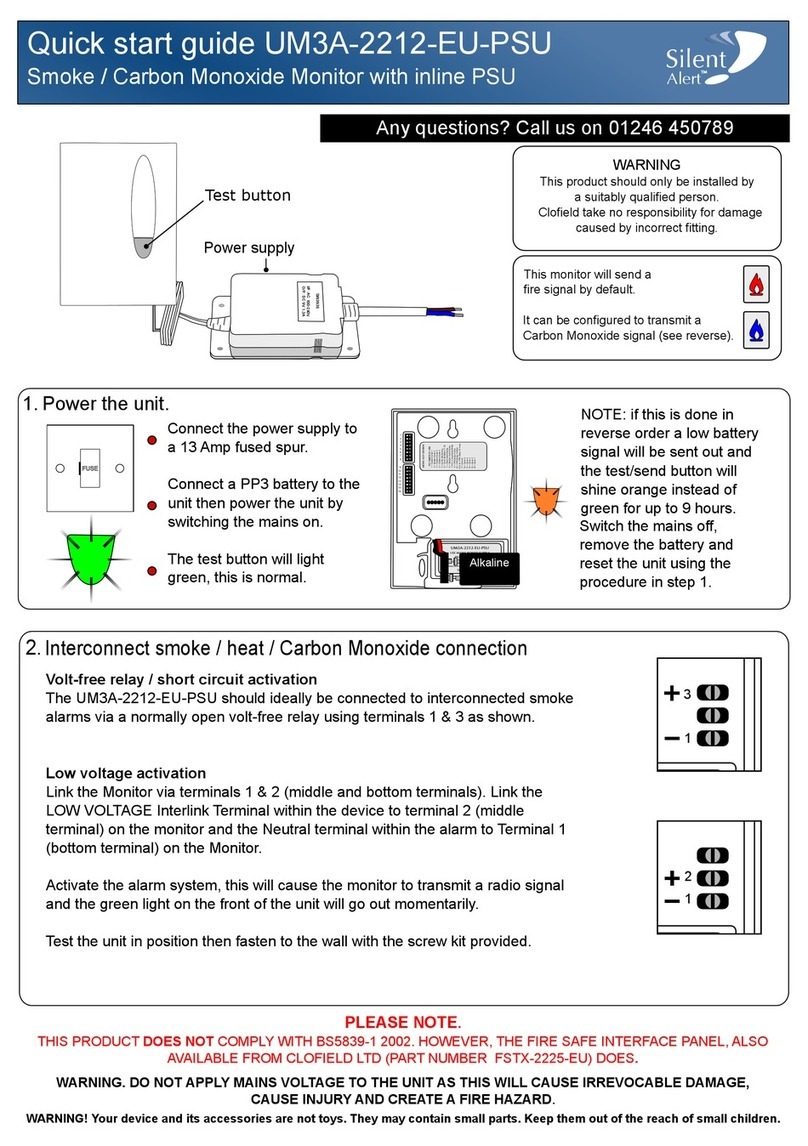
Silent Alert
Silent Alert UM3A-2212-EU-PSU quick start guide
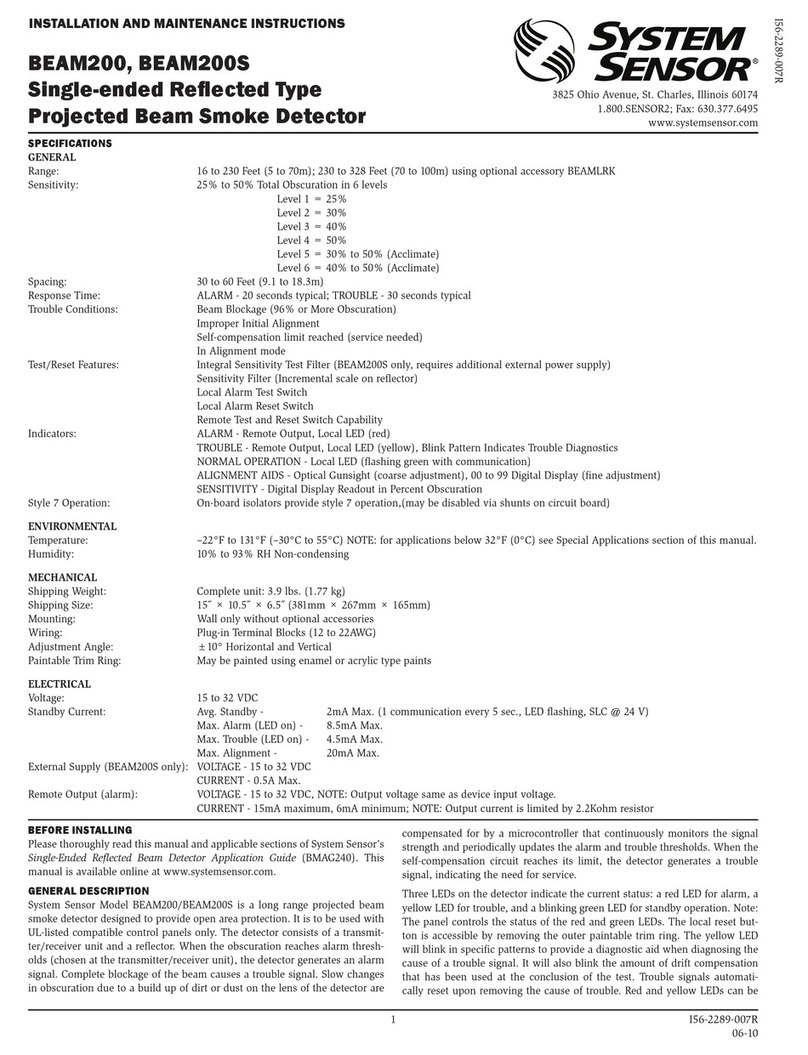
System Sensor
System Sensor BEAM200 Installation and maintenance instructions
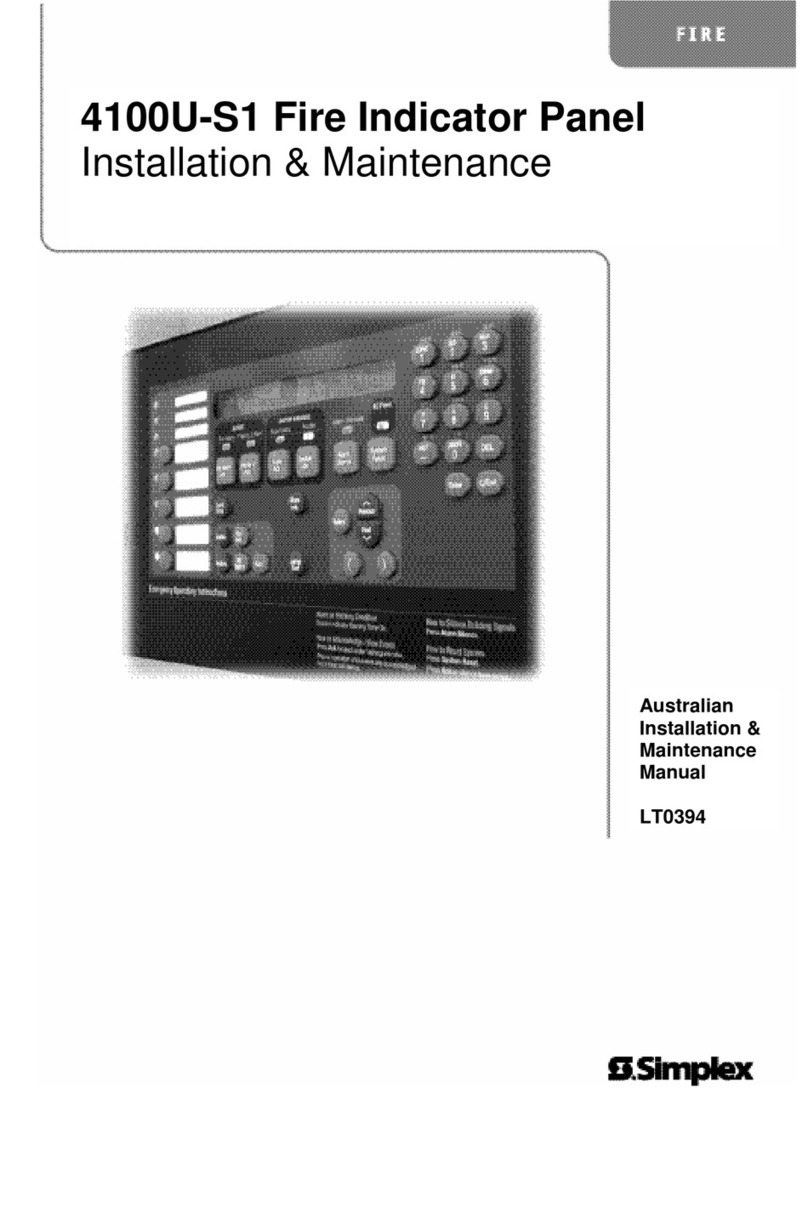
Simplex
Simplex 4100U-S1 Installation and Maintenance

System Sensor
System Sensor Innovair DH200PL Installation and maintenance instructions
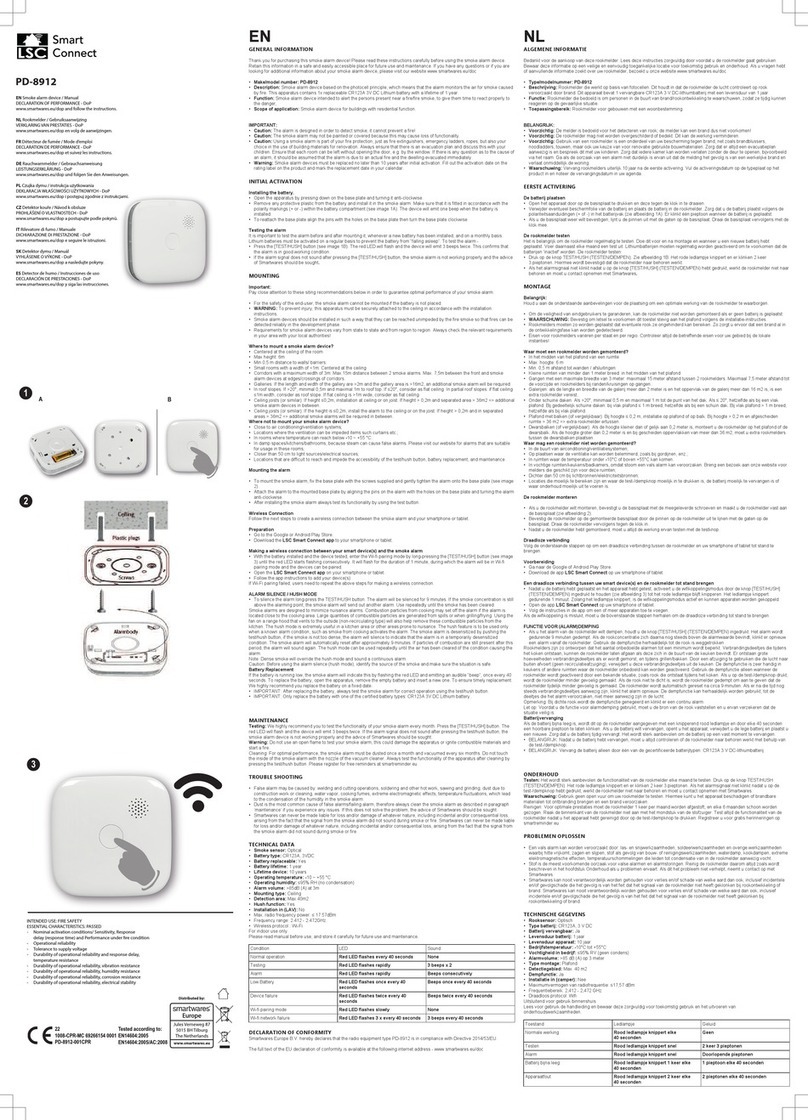
LSC
LSC Smart Connect PD-8912 manual
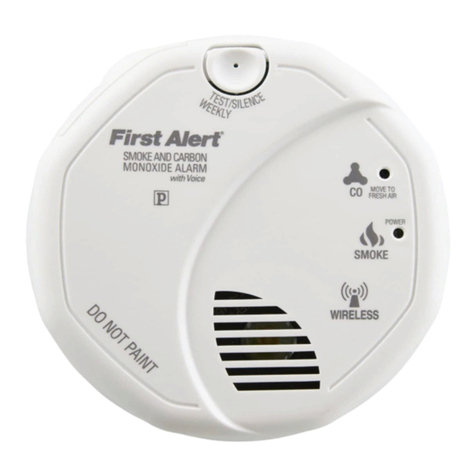
First Alert
First Alert ONELINK SCO501B2 user manual
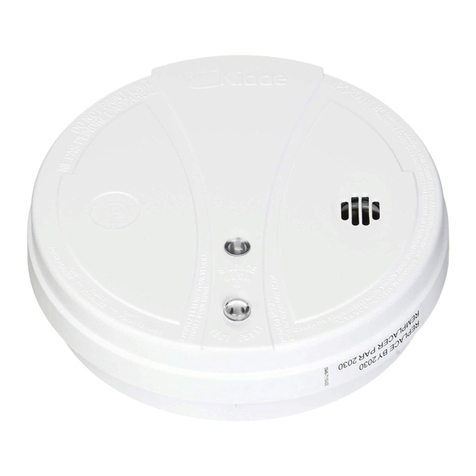
Kidde
Kidde 0915CA user manual
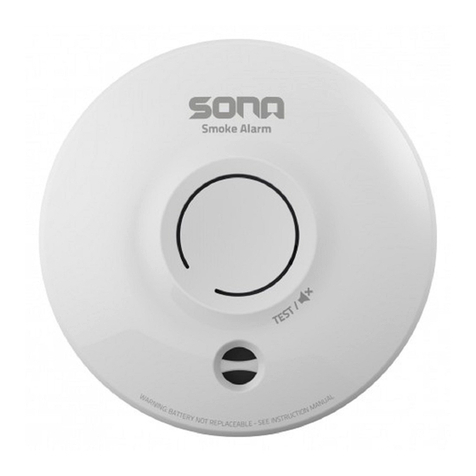
SONA Electronics
SONA Electronics SM-SN-1 Installation and user guide

Cavius
Cavius 3103-002 user guide

Universal Security Instruments
Universal Security Instruments MDS300 instructions
Brooks
Brooks firetracker FT1020G3 FDCIE Operation manual

